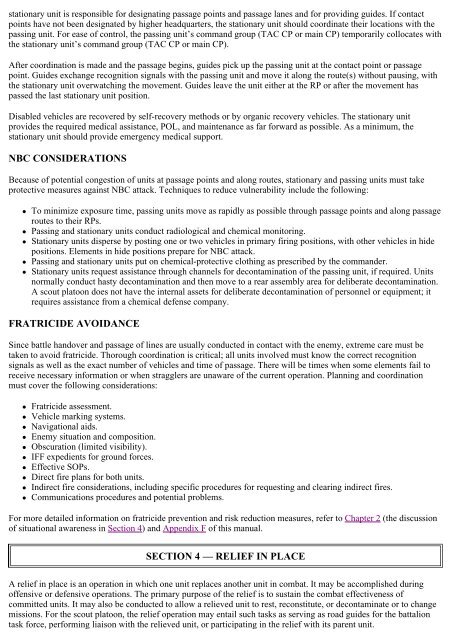FM 17-98 SCOUT PLATOON
FM 17-98 SCOUT PLATOON
FM 17-98 SCOUT PLATOON
You also want an ePaper? Increase the reach of your titles
YUMPU automatically turns print PDFs into web optimized ePapers that Google loves.
stationary unit is responsible for designating passage points and passage lanes and for providing guides. If contact<br />
points have not been designated by higher headquarters, the stationary unit should coordinate their locations with the<br />
passing unit. For ease of control, the passing unit’s command group (TAC CP or main CP) temporarily collocates with<br />
the stationary unit’s command group (TAC CP or main CP).<br />
After coordination is made and the passage begins, guides pick up the passing unit at the contact point or passage<br />
point. Guides exchange recognition signals with the passing unit and move it along the route(s) without pausing, with<br />
the stationary unit overwatching the movement. Guides leave the unit either at the RP or after the movement has<br />
passed the last stationary unit position.<br />
Disabled vehicles are recovered by self-recovery methods or by organic recovery vehicles. The stationary unit<br />
provides the required medical assistance, POL, and maintenance as far forward as possible. As a minimum, the<br />
stationary unit should provide emergency medical support.<br />
NBC CONSIDERATIONS<br />
Because of potential congestion of units at passage points and along routes, stationary and passing units must take<br />
protective measures against NBC attack. Techniques to reduce vulnerability include the following:<br />
• To minimize exposure time, passing units move as rapidly as possible through passage points and along passage<br />
routes to their RPs.<br />
• Passing and stationary units conduct radiological and chemical monitoring.<br />
• Stationary units disperse by posting one or two vehicles in primary firing positions, with other vehicles in hide<br />
positions. Elements in hide positions prepare for NBC attack.<br />
• Passing and stationary units put on chemical-protective clothing as prescribed by the commander.<br />
• Stationary units request assistance through channels for decontamination of the passing unit, if required. Units<br />
normally conduct hasty decontamination and then move to a rear assembly area for deliberate decontamination.<br />
A scout platoon does not have the internal assets for deliberate decontamination of personnel or equipment; it<br />
requires assistance from a chemical defense company.<br />
FRATRICIDE AVOIDANCE<br />
Since battle handover and passage of lines are usually conducted in contact with the enemy, extreme care must be<br />
taken to avoid fratricide. Thorough coordination is critical; all units involved must know the correct recognition<br />
signals as well as the exact number of vehicles and time of passage. There will be times when some elements fail to<br />
receive necessary information or when stragglers are unaware of the current operation. Planning and coordination<br />
must cover the following considerations:<br />
• Fratricide assessment.<br />
• Vehicle marking systems.<br />
• Navigational aids.<br />
• Enemy situation and composition.<br />
• Obscuration (limited visibility).<br />
• IFF expedients for ground forces.<br />
• Effective SOPs.<br />
• Direct fire plans for both units.<br />
• Indirect fire considerations, including specific procedures for requesting and clearing indirect fires.<br />
• Communications procedures and potential problems.<br />
For more detailed information on fratricide prevention and risk reduction measures, refer to Chapter 2 (the discussion<br />
of situational awareness in Section 4) and Appendix F of this manual.<br />
SECTION 4 — RELIEF IN PLACE<br />
A relief in place is an operation in which one unit replaces another unit in combat. It may be accomplished during<br />
offensive or defensive operations. The primary purpose of the relief is to sustain the combat effectiveness of<br />
committed units. It may also be conducted to allow a relieved unit to rest, reconstitute, or decontaminate or to change<br />
missions. For the scout platoon, the relief operation may entail such tasks as serving as road guides for the battalion<br />
task force, performing liaison with the relieved unit, or participating in the relief with its parent unit.











